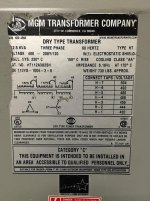cinematechnic
Cast Iron
- Joined
- Apr 11, 2005
- Location
- Walnut Creek, CA
Now that I have my first workshop set up that will be the site of my machine shop, I was hoping I can get advice on the following:
I want to know any strategies that can reduce the noise level of a large dry transformer.
Here are the transformer specs:
DRY TYPE TRANSFORMER
12.5 KVA, Three Phase, 60 Hz, Type HT
Voltage 480 - 208Y/120
W(1) Electrostatic Shield
Insul Sys. 220ºC, 150ºC Rise, Cooling Class "AA"
Impedance 6.16% at 170º C

The transformer emits a substantial amount of hum/buzz noise. Here's what I've noticed:
It's loudest when there is no load on it.
When I connected a heater to a 120V outlet powered by the transformer it seems to get quieter.
When I run my Schaublin lathe unloaded on the low speed (1.1 HP), the transformer seems to get much quieter. It's difficult to know how much because you are listening for the sound of the transformer and trying to ignore the sound of the lathe motor/spindle spinning.
The lathe is currently the only load I can apply that equally loads all 3 phases.
I'm curious to know if a small noiseless load applied equally to all 3 phases might quiet the transformer. For example: 3 equal wattage incandescent light bulbs each connected to one phase and neutral.
Thanks in advance for your input!
I want to know any strategies that can reduce the noise level of a large dry transformer.
Here are the transformer specs:
DRY TYPE TRANSFORMER
12.5 KVA, Three Phase, 60 Hz, Type HT
Voltage 480 - 208Y/120
W(1) Electrostatic Shield
Insul Sys. 220ºC, 150ºC Rise, Cooling Class "AA"
Impedance 6.16% at 170º C

The transformer emits a substantial amount of hum/buzz noise. Here's what I've noticed:
It's loudest when there is no load on it.
When I connected a heater to a 120V outlet powered by the transformer it seems to get quieter.
When I run my Schaublin lathe unloaded on the low speed (1.1 HP), the transformer seems to get much quieter. It's difficult to know how much because you are listening for the sound of the transformer and trying to ignore the sound of the lathe motor/spindle spinning.
The lathe is currently the only load I can apply that equally loads all 3 phases.
I'm curious to know if a small noiseless load applied equally to all 3 phases might quiet the transformer. For example: 3 equal wattage incandescent light bulbs each connected to one phase and neutral.
Thanks in advance for your input!


